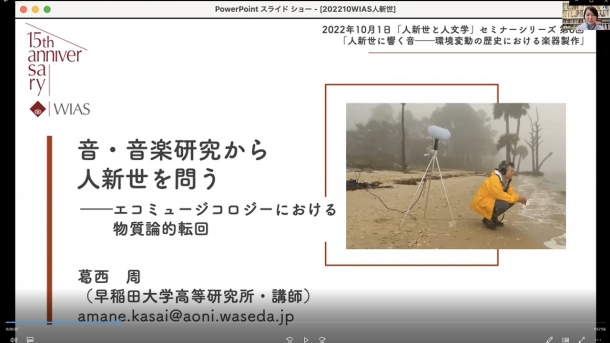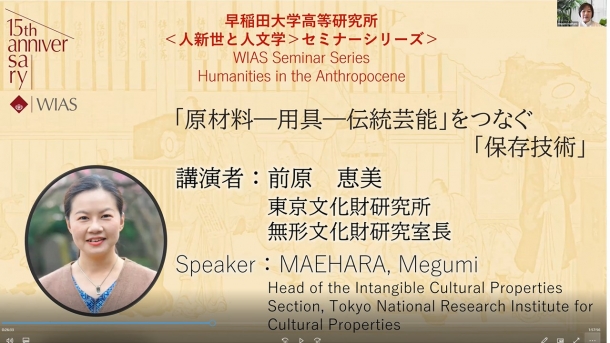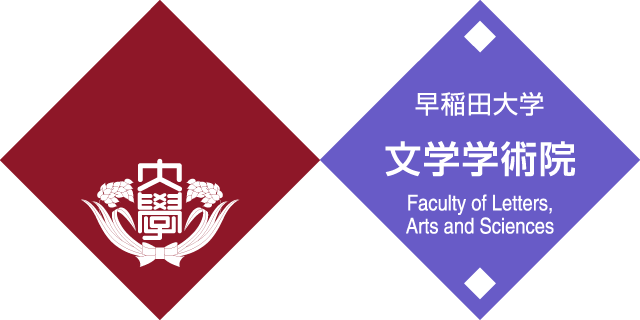- News
- Event Report: WIAS Seminar Series “Humanities in the Anthropocene” Vol. 6 Open Lecture – “Sounds Echoing in the Anthropocene: Making Musical Instruments throughout the History of Environmental Change”
Event Report: WIAS Seminar Series “Humanities in the Anthropocene” Vol. 6 Open Lecture – “Sounds Echoing in the Anthropocene: Making Musical Instruments throughout the History of Environmental Change”

- Posted
- 2022年10月27日(木)
This lecture was organized as the sixth public lecture in the seminar series “Humanities in the Anthropocene,” a research project of the Waseda Institute for Advanced Study. The lecture was attended by 36 participants from Japan and abroad, and was followed by a lively discussion.
First, Amane KASAI (Waseda Institute for Advanced Study) introduced trends in sound and music research connectable to the Anthropocene framework. She explained attempts to aurally capture environmental characteristics and changes, using examples such as the fixed-point field recordings of coral reefs by Bernie Krause, a proponent of soundscape ecology. As an example, she presented the sounds coming from a coral reef in a healthy environment with a lot of fish, and from a sea with dying coral, the difference of which amazed us. This provided a new perspective of an environment seen (and heard) even with our eyes closed. The topic also expanded to the perspective of material culture in the Anthropocene, including the relationship between musical media materials such as shellac discs and music distribution after the modern era, as well as the challenges in musical instrument production with import restrictions on animal- and plant-derived materials.
Next, Megumi MAEHARA (Tokyo National Research Institute for Cultural Properties), a specialist in intangible cultural heritage studies and cultural property preservation techniques, gave a lecture on the techniques and materials used in the production of musical instruments used in traditional Japanese performing arts, in relation to the natural and social environment. The production of a single shamisen requires a large number of detailed accessories, each of which has a history of manufacturing with specialists engaged in each process. In recent years, however, she noted that the division of labor is reaching its limits with a shortage of makers. The small instrument, the shamisen, brought to light a serious problem: the importance of not only securing raw materials and tools, but also the existence of makers with inherited preservation techniques, and performers with the skills to practice traditional performing arts using the instrument. In addition, she also expressed her vision for the future, that the solution to securing stable supplies of raw materials and tools lies not only in long-term verification of new and alternative materials through the cooperation of performers as well as producers, but also in exploring the possibilities of collaboration across genres of traditional performing arts and traditional culture.

In the Q&A session, questions were asked about the background stimulating demand for traditional performing arts, such as ideology, society, and national systems, as well as about foreign interest and linkage with restoration and preservation activities overseas. This theme overlapped greatly with the changes in painting techniques and materials discussed in the second lecture of the Seminar on the Anthropocene, suggesting that the specific intersections among various fields became clearer as the number of seminars increased.
Event details
- Date/Time: October 1, 2022 (Sat.), 10:00~12:00 (JST)
- Location: Online meeting via Zoom (prior registration required)
- Program:
10:00~10:05 Opening Remarks
10:05~10:25 Exploring the Anthropocene from the Field of Music and Sound Studies: The Material Turn in Ecomusicology, Amane KASAI (Assistant Professor, Waseda Institute for Advanced Study)
10:25~11:10 Lecturer “Conservation Techniques” Linking “Materials, Tools, and Traditional Performing Arts”, Megumi MAEHARA, (Head, Intangible Cultural Properties Section, Tokyo National Research Institute for Cultural Properties)
11:15~12:00 Q&A and discussion
- Chair: Satomi Yamamoto (Professor, Faculty of Letters, Arts and Sciences, Waseda University)
- Prospected Audience: Faculty members, Researchers, Graduate students
- Tags
- Event Reports
